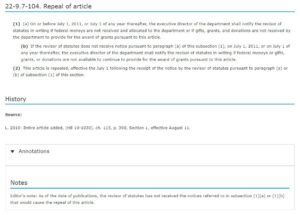by Jennifer Gilroy
Recently it came to my attention that a significant change in the law took place right after the Office of Legislative Legal Services (Office) had approved the proof print for the final title of the Colorado Revised Statutes (C.R.S.) and sent it off to our printers, LexisNexis, for formatting, printing, and distribution. At that moment I knew the beautiful set of burgundy-colored leatherette soft-bound volumes that this office had worked on so meticulously for the preceding three months would be sadly out of date the moment they would be delivered.
 You might wonder how the Office didn’t know that there would be a change in the law and account for it in the official publication. It is because, on occasion, bills are written in anticipation of an event that is expected to occur at some unknown time in the future. That event is the trigger for a new law to take effect or for an existing law to repeal. For example, a bill creating a new program may provide that the new law will not take effect until the federal Department of Health and Human Services grants a waiver to the state Department of Human Services to implement the program that the bill creates. In that situation, the drafter typically includes a provision in the law directing the executive director of the state Department of Human Services to notify the revisor of statutes when the triggering event has occurred, and, with that notice, the new law comes to life. However, if the triggering event—or even the receipt of the notice of the triggering event—occurs after August 10th, it is too late to change the books. August 10th is the cut-off date by which the Office must approve the final proof print for the publication of the Official C.R.S. No changes can be made to the printed C.R.S. thereafter.
You might wonder how the Office didn’t know that there would be a change in the law and account for it in the official publication. It is because, on occasion, bills are written in anticipation of an event that is expected to occur at some unknown time in the future. That event is the trigger for a new law to take effect or for an existing law to repeal. For example, a bill creating a new program may provide that the new law will not take effect until the federal Department of Health and Human Services grants a waiver to the state Department of Human Services to implement the program that the bill creates. In that situation, the drafter typically includes a provision in the law directing the executive director of the state Department of Human Services to notify the revisor of statutes when the triggering event has occurred, and, with that notice, the new law comes to life. However, if the triggering event—or even the receipt of the notice of the triggering event—occurs after August 10th, it is too late to change the books. August 10th is the cut-off date by which the Office must approve the final proof print for the publication of the Official C.R.S. No changes can be made to the printed C.R.S. thereafter.
This is particularly frustrating when I receive a notice to the revisor after August 10th, but I learn from the notice that the triggering event (the approval of the waiver in my example) actually occurred a month or two earlier when the Office could have identified in an editor’s note that the triggering event had occurred and that the law is effective. Instead, however, the reader only sees the law printed in the books, accompanied by an editor’s note that reads, “As of the publication date, the revisor of statutes has not received the notice referred to in subsection (1).” When the reader sees that type of note, he or she does not know whether the law is in effect or merely pending the event. It’s even more confusing when the triggering event ultimately results in the repeal of a law already on the books. In that situation, the reader can see the law published in the official statutes, but the editor’s note does not help the reader understand whether the law is still in effect.
On the other hand, the online version of the C.R.S. is much more nimble and can be easily updated to reflect that the triggering event has occurred and that the law in question is now in effect or repealed, as the case may be. Working with our partners at LexisNexis, the Office can update the editor’s notes and remove repealed law that is no longer effective on a real-time basis. But should the online version, accessible through the General Assembly’s website, be different from the C.R.S. books?
For years I have struggled with that dilemma for two reasons: One, I’ve historically believed that both the book version and the online version of the C.R.S., in addition to the DVD, should be
identical so that two different people reading the law published by the General Assembly don’t see two different versions. Second, the books are still the only “official” version of the Colorado’s

primary statutory law. See §2-5-118, C.R.S. Until the legislature can ensure compliance with the three requirements of the Uniform Electronic Legal Material Act (See article 71.5 of title 24, C.R.S.) to allow the online version to also be an “official” source of the primary statutory law, those lovely burgundy leatherette books remain the only official version of Colorado’s statutory law. But, while the online version cannot be official, it could be more up-to-date.
After significant rumination on the subject, I have decided to change my historical approach of keeping all versions of the C.R.S. the same, and begin updating the online version as new information becomes available that will affect the law presented in the C.R.S. This decision is based primarily on a belief that public expectations likely favor timely online updates to reflect the current state of the law. Most people recognize that the books cannot be updated and changed as information becomes available over the course of the year without costly errata supplements, but they presume a vibrant website source can be. Therefore, going forward, the Office will update the online statutes as we receive notices that indicate a change in the law has occurred.
What to take away from this article? I recommend that when doing research, feel free to conduct your research using the online version of the C.R.S. (https://leg.colorado.gov/colorado-revised-statutes) to see the most updated state of the law. But for official court filings or other formal business, confirm the text with the official version in the books. If you are still in doubt, call the Office of Legislative Legal Services.
